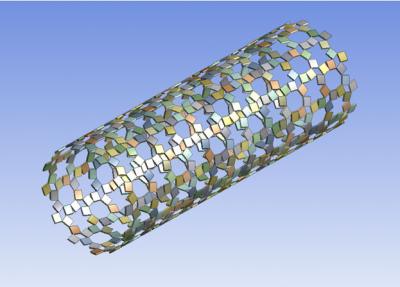
CREDIT
Metamaterials Unit, Department of Chemistry, University of Malta
A new logic-defying mathematical model could lead to materials for better skin grafts and new smart materials
Wake up in the morning and stretch; your midsection narrows. Pull on a piece of plastic at separate ends; it becomes thinner. So does a rubber band. One might assume that when a force is applied along an axis, materials will always stretch and become thinner. Wrong. Thanks to their peculiar internal geometry, auxetic materials grow wider when stretched. After confounding scientists for decades, University of Malta researchers are now developing mathematical models to explain the unusual behaviour of these logic-defying materials, unlocking a plethora of applications that could change the way we envision the future forever.
Auxetic materials have the amazing property of a negative Poisson’s ratio, becoming fatter when stretched. This comes from its structure which in the Malta-developed model is represented by a series of connected squares, technically called rigid, rotating subunits. When the subunits turn relative to one another, the material’s density lowers but its thickness increases.
Auxetics caused such colossal confusion among researchers that it went ignored for years. It was only in the 1980s that auxetics were picked up again as practical application resurfaced. Recent advances are unlocking this material’s potential.
In a paper published last week in Nature Publishing Group’s journal Scientific Reports, mechanical metamaterials, chemistry professor Joseph N Grima, together with his team at the University of Malta, have presented a mathematical model of auxetic behaviour using hierarchical rotating unit systems.
These systems take advantage of the enhanced properties provided by a negative Poisson’s ratio but also use a hierarchical system whereby the complex structures are created from the simpler units, thus creating a hierarchical auxetic metamaterials that are more versatile in terms of their mechanical properties, with experts being able to control and alter them.
Emeritus Professor Anselm C Griffin (Georgia Institute of Technology, US), notes how Grima’s work “represents a huge step forward in the conceptualization and design of a new class of metamaterials.” “With the realistic prospect of tailorable auxetic mechanical properties as described in this paper, the potential for applications of these new metamaterial structures particularly in biomedicine and catalysis is quite exciting,” he added.
Materials Chemistry Professor at Oxford University in the United Kingdom, Andrew Goodwin, notes its “exciting [applications], how fractal-like assemblies of simple [shapes] might find application in smart medical stents and ultralight responsive supports.” In principle, he said, the ideas Grima and his team are working on could also be applied to atomic-scale assemblies as they do in life-size structures. Chemists and engineers will be working closer together to develop the smart materials of the future, he added.
Read more: The building blocks of the future defy logic
The Latest on: Auxetic materials
[google_news title=”” keyword=”Auxetic materials” num_posts=”10″ blurb_length=”0″ show_thumb=”left”]
via Google News
The Latest on: Auxetic materials
- Materials science articles from across Nature Portfolioon April 25, 2024 at 5:00 pm
Materials science is an interdisciplinary field concerned with the understanding and application of the properties of matter. Materials scientists study the connections between the underlying ...
- Expert-Defying Anomaly – Scientists Discover 2D Nanomaterial With Counter-Intuitive Expanding Propertieson April 25, 2024 at 5:25 am
It is a common hack to stretch a balloon out to make it easier to inflate. When the balloon stretches, the width crosswise shrinks to the size of a string. Noah Stocek, a PhD student collaborating ...
- Materials Science Newson April 23, 2024 at 5:00 pm
Apr. 24, 2024 — A mystery that has puzzled the scientific community for over 50 years has finally been solved. A team has discovered that a certain type of chemical reaction can explain why ...
- Applied Materials Inc AMATon April 22, 2024 at 4:59 pm
We sell different types of products and services to both investment professionals and individual investors. These products and services are usually sold through license agreements or subscriptions ...
- Basic Materials Roundup: Market Talkon April 18, 2024 at 10:41 am
The latest Market Talks covering Basic Materials. Published exclusively on Dow Jones Newswires at 4:20 ET, 12:20 ET and 16:50 ET. 1214 ET – Alcoa is liking the look of potential higher tariffs ...
- A nanomaterial that defies classic physics lawson April 18, 2024 at 7:23 am
However, Noah Stocek, a PhD student in collaboration with Western physicist Giovanni Fanchini, fabricated a nanomaterial, defined by its tiny size, that defies this natural order.
- Laser-patterned thin films that swell into kirigami-like structures offer new opportunities in hydrogel technologyon April 11, 2024 at 10:01 am
Adaptive plasticity of auxetic Kirigami hydrogel fabricated from anisotropic swelling of cellulose nanofiber film, Science and Technology of Advanced Materials (2024). DOI: 10.1080/14686996.2024. ...
- recycled materials: The Latest Architecture and Newson April 9, 2024 at 5:00 pm
In this context, and similarly to the idea expressed by Alvar Aalto, who stated that "modern architecture does not imply the use of new materials, but rather employing existing materials more ...
- MP Materials Insider Ups Holding During Yearon April 8, 2024 at 5:00 pm
Viewing insider transactions for MP Materials Corp.'s (NYSE:MP ) over the last year, we see that insiders were net buyers. This means that a larger number of shares were purchased by insiders in ...
- Curious by nature: explore what's new in Ferrino Spring Summer 2024on April 3, 2024 at 5:00 pm
This collaboration produced the new line of Ferrino HIKEMASTER backpacks with shoulder straps made of auxetic material. Using this material represents a real revolution in the world of backpacks, so ...
via Bing News









